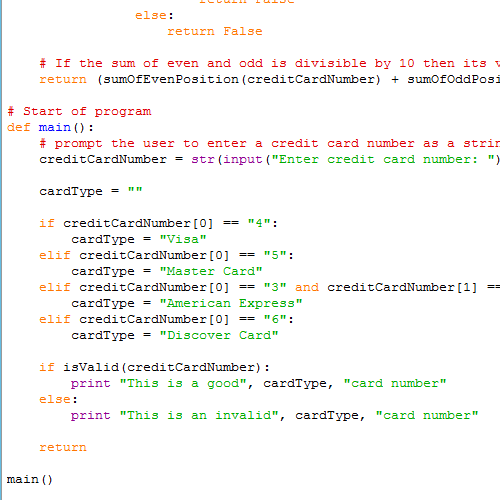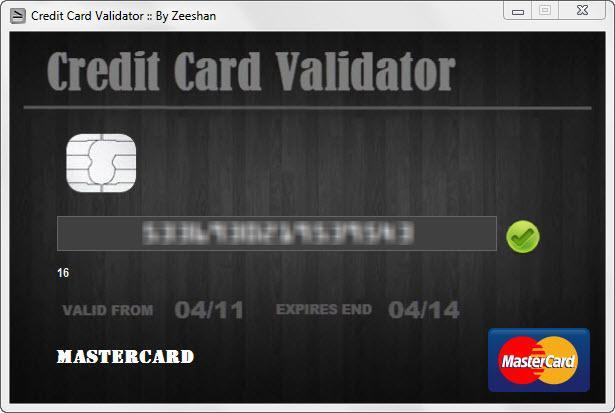

For instance, you can replace: if () < card: You can simplify the way you return a boolean result from your methods. revise the quality and necessity of comments: there is probably not much sense in having a comment # Constructor.consistent naming: rename postcode to post_code.It is a little bit cleaner to do this way since now our class is more generic, it is agnostic of where the attributes are coming from.

I would also pass the obtained attributes to the class constructor instead of asking for them inside it: def _init_(self, name, post_code, card_date, card_code): name attribute, consists of credit-card related logic only. This is the file where well be writing our brute force script. Also, all valid cards must have exactly 16 digits.
#Credit card validator python code#
I think there is this code organization issue - you have a class named Customer, but it, aside from the. Create a new Python script file and save it as creditcard.py. Given a credit card number, validate that it is valid using the Luhn test. """Function used to test if a number is even.""" If self.check_code() and self.check_date(): # If the code is divisible by 10, returns True, else, it returns False. # For each digit, if it is greater than 9 9 is subtracted from it. If it is valid, returns True else False."""Ĭard = (self.card_date, "%d/%m/%Y").date() """Checks current date against the credit card's date. Self.card_code = input("Card code: ").strip() """Class representing the customer and their credit card details""" The code: """Program used to check if a credit card is authentic."""

The card date must also be in the future.įinally, output their name, postcode, card number, and whether it is If the sum of the 7 digits, and the check digit are divisable by 10, If the result of the multiplication is > 9, subtract 9 from it. The 1st, 3rd, 5th, and 7th digits are multiplied by 2 The eighth digit of the card code is removed and acts as a check digit The user enters their name, postcode, the card code, and the card I am wondering if you could review my code, both appraising the actual code, but also evaluate my use of OOP/classes. Having no experience with classes in the past, I decided to employ classes in this project. If the result from step 4 is divisible by 10, the card number is valid otherwise, it is invalid. Add all digits in the odd places from right to left in the credit card number. While reinventing the wheel can be good sometimes, it is also important to look for existing resources before starting.Just completed a piece of code - a credit card validation program in python - as a little side project. Now add all single digit numbers from step 1.
#Credit card validator python how to#
This review focuses more on how to properly implement Luhn's algorithm. Take his advice at heart and you will be a great coder in no time. Nivs gave a great review of your code, despite some minor flaws in the improvements. I'd postpone your integer conversion of the input string, since it's really easy to test the length while it's still a str: def main():Īnd I would move main towards the bottom of the script. Replace your if/ elif statements with a dictionary: card_types = )Ĭard_type = card_types python validator iran national-identification-number iban-validator python-package credit-card-validation. Return num // 10 ** (int(math.log10(num)) - 1)Īnd checking for a type of card lends itself to using a dictionary Credit Card Types IBAN, National Id, Credit Card Number and Phone number validator tool. I also think that my implementation of Luhn's Algorithm could be improved, considering I looped over the card number twice.Ī solution for this in constant space and time is already documented in this answer: from math import log10

If len(str(nums)) > 16 or len(str(nums)) 50 and num < 56:Ĭould someone please review my code if it follows good practice and style? I want to be more Pythonic as I continue to learn. Originally written in C (which was abysmal, you may check here if you want), I rewrote my simple credit card validation program using Python def main():


 0 kommentar(er)
0 kommentar(er)
